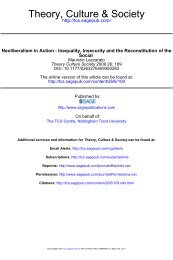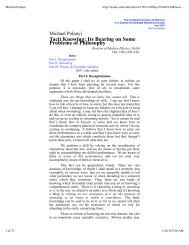PUBLIC OPINION by WALTER LIPPMANN TO FAYE LIPPMANN ...
PUBLIC OPINION by WALTER LIPPMANN TO FAYE LIPPMANN ...
PUBLIC OPINION by WALTER LIPPMANN TO FAYE LIPPMANN ...
You also want an ePaper? Increase the reach of your titles
YUMPU automatically turns print PDFs into web optimized ePapers that Google loves.
People differ widely in their susceptibility to ideas. There are some<br />
in whom the idea of a starving child in Russia is practically as vivid<br />
as a starving child within sight. There are others who are almost<br />
incapable of being excited <strong>by</strong> a distant idea. There are many<br />
gradations between. And there are people who are insensitive to facts,<br />
and aroused only <strong>by</strong> ideas. But though the emotion is aroused <strong>by</strong> the<br />
idea, we are unable to satisfy the emotion <strong>by</strong> acting ourselves upon<br />
the scene itself. The idea of the starving Russian child evokes a<br />
desire to feed the child. But the person so aroused cannot feed it. He<br />
can only give money to an impersonal organization, or to a<br />
personification which he calls Mr. Hoover. His money does not reach<br />
that child. It goes to a general pool from which a mass of children<br />
are fed. And so just as the idea is second hand, so are the effects of<br />
the action second hand. The cognition is indirect, the conation is<br />
indirect, only the effect is immediate. Of the three parts of the<br />
process, the stimulus comes from somewhere out of sight, the response<br />
reaches somewhere out of sight, only the emotion exists entirely<br />
within the person. Of the child's hunger he has only an idea, of the<br />
child's relief he has only an idea, but of his own desire to help he<br />
has a real experience. It is the central fact of the business, the<br />
emotion within himself, which is first hand.<br />
Within limits that vary, the emotion is transferable both as regards<br />
stimulus and response. Therefore, if among a number of people,<br />
possessing various tendencies to respond, you can find a stimulus<br />
which will arouse the same emotion in many of them, you can substitute<br />
it for the original stimuli. If, for example, one man dislikes the<br />
League, another hates Mr. Wilson, and a third fears labor, you may be<br />
able to unite them if you can find some symbol which is the antithesis<br />
of what they all hate. Suppose that symbol is Americanism. The first<br />
man may read it as meaning the preservation of American isolation, or<br />
as he may call it, independence; the second as the rejection of a<br />
politician who clashes with his idea of what an American president<br />
should be, the third as a call to resist revolution. The symbol in<br />
itself signifies literally no one thing in particular, but it can be<br />
associated with almost anything. And because of that it can become the<br />
common bond of common feelings, even though those feelings were<br />
originally attached to disparate ideas.<br />
When political parties or newspapers declare for Americanism,<br />
Progressivism, Law and Order, Justice, Humanity, they hope to<br />
amalgamate the emotion of conflicting factions which would surely<br />
divide, if, instead of these symbols, they were invited to discuss a<br />
specific program. For when a coalition around the symbol has been<br />
effected, feeling flows toward conformity under the symbol rather than<br />
toward critical scrutiny of the measures. It is, I think, convenient<br />
and technically correct to call multiple phrases like these symbolic.





